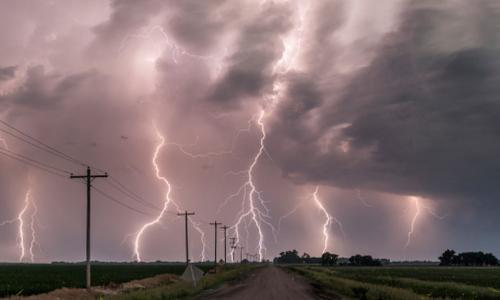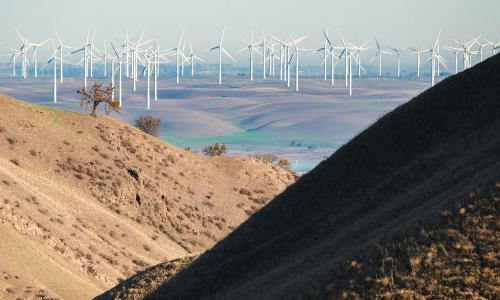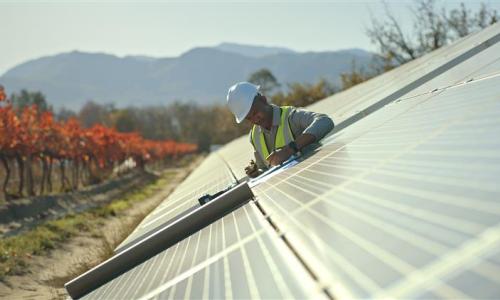A reliable, resilient power grid is one that can "keep the lights on" through extreme weather events like hurricanes, wildfires, or blizzards. But the grid today is woefully unprepared to meet our current climate reality—and that leaves communities facing perilous, sometimes deadly, outcomes.
Achieving a climate-resilient power grid will take rigorous planning. And because the electric transmission system investments we make today will be in operation for a half century or more, the time to act is now.
Planning that incorporates community voices and integrates science-based climate risk assessments will ensure a power grid that is more resilient, more cost-effective, and does not perpetuate the inequities in climate-burdened communities that the status quo would unjustly ignore.
Keeping Everyone's Lights On
This is a portion of the full report. The full report can be downloaded here.
Most of us do not register how much we rely on the power grid to keep us safe during extreme weather—until it fails. Extreme weather events have long been a driver of power failure, but as they become more frequent and severe due to fossil fuel-driven climate change, outages also grow in frequency and severity. Consequently, we need a resilient electric grid that responds to, withstands, and quickly recovers from extreme weather events such as severe winter weather, rapidly intensifying hurricanes, and large wildfires. A climate-resilient power system can save lives, especially in communities with fewer resources to protect themselves from, and rebound after, extreme weather events.
To build the power grid's resilience, it is critical to have robust regional and interregional transmission—transmission carried out by the large, high-voltage lines that connect multiple utility service territories and strengthen the system across large geographic regions. A resilient transmission system enables access to a more diverse set of power plants located farther from areas affected by extreme weather and provides redundancy so that no community is overly dependent on a single transmission line. In this way, the transmission system complements other more localized solutions to limit the potential for extended or widespread power outages and assist in the timely restoration of power.
More frequent and severe extreme weather events driven by climate change are creating a higher-risk environment for transmission systems. The entities responsible for planning and ultimately deciding how we invest in the transmission system to meet future needs—utilities, states, and regional transmission operators—must evolve their processes to take advantage of scientific and analytic advances that can help mitigate risk and inform climate resilience strategies. To that end, we offer the following recommendations:
-
Assess climate risks. Conduct forward-looking, science-informed climate risk assessments using the best available, properly scaled climate data that project impacts at least 30 years into the future and across multiple emissions pathways to capture a reasonable range of extreme weather risks.
-
Acknowledge the role of fossil fuel reliance in exacerbating grid vulnerabilities to extreme weather. Maximize the value and impact of resilience investments by integrating transmission planning with actions that accelerate the transition away from fossil fuels.
-
Reform planning processes. Establish transmission planning processes that analyze a broad range of potential future conditions, including extreme weather risks and other key drivers of change, such as demand growth, electrification, and the transition to clean energy. Planning processes should be the foundation for cost-effective investment in the transmission system to build resilience to climate change and extreme weather.
-
Collaborate with researchers. Greater collaboration between climate science researchers, electricity systems researchers, system planners, and decisionmakers can help develop the tools required for robust planning, ensure their workability from day one, and facilitate rapid adoption by the planning community.
As system-level processes to plan for and invest in the transmission system are changed to address climate change, more focus must be placed on the populations and communities most vulnerable to the extended power outages that result from transmission system failures. Without this focus, investments risk perpetuating existing inequities and failing those needing protection most, as many of the current resilience frameworks do not account for the disparities in resources and infrastructure among communities.
To achieve more equitable and community-informed outcomes, we must update the metrics used to evaluate how we invest to bolster the transmission system against extreme weather and integrate them with new, community-focused tools. We must also make room for community voices at decisionmaking tables for their input and influence. We recommend the following measures:
-
Improve the metrics used to make decisions about transmission system investment to be more reflective of how the costs of power outages vary significantly across time and space as well as among communities.
-
Complement economic-focused metrics with additional metrics or qualitative assessments—transparently developed in coordination with local government, state decisionmakers, and communities—that consider vulnerable communities and populations in how we invest in a more resilient transmission system.
-
Improve coordination and collaboration across transmission, distribution, and community efforts so that regional and interregional transmission investments complement resilience-based investments made at the utility and local levels.
-
Make decisionmaking more inclusive and responsive to the unique needs of communities by establishing and maintaining meaningful community engagement for better-informed consideration of the impacts and trade-offs of different investment options to build system resilience. The next set of recommendations can help achieve this objective.
-
Incorporate energy justice principles that focus on achieving equity in social and economic participation within the energy system while also addressing the disproportionate burdens faced by marginalized communities. Integrating these principles, including assessing cumulative impacts, shapes resilience planning that actively works to remedy past injustices and prevent future disparities.
-
Develop shared governance structures that create and compensate community advisory boards with explicit decisionmaking power.
-
Engage early, including reaching out before plans are drafted to build trust and ensure that community priorities guide project design.
-
Align with local resilience efforts so that bulk system investments support rather than override community efforts.
-
Support community capacity by including funding for technical assistance, providing translated and simplified planning tools, and compensating communities for their time and expertise.
-
Embed accountability tools by using equity impact statements, resilience benefit-cost ratios, and dashboards so that outcomes are community-informed and track progress transparently over time.
-
These recommendations are meant to enable more informed and constructive discussions about how to plan for and invest in an equitable and resilient transmission system that can meet the challenges posed by a changing climate. Achieving this goal will take a critical mass of communities, advocacy organizations, consumer advocates, and other interested parties pushing for science-informed climate risk assessments, modernized analytic capabilities, community engagement, and a reevaluation of the multiple benefits of avoided power outages.
Downloads
Citation
Gomberg, Sam, Rachel Licker, Sital Sathia, and Pamela Worth. 2025. Keeping Everyone's Lights On: How to Build an Equitable, Climate-Resilient Power Grid. Cambridge, MA: Union of Concerned Scientists. https://doi.org/10.47923/2025.15855





